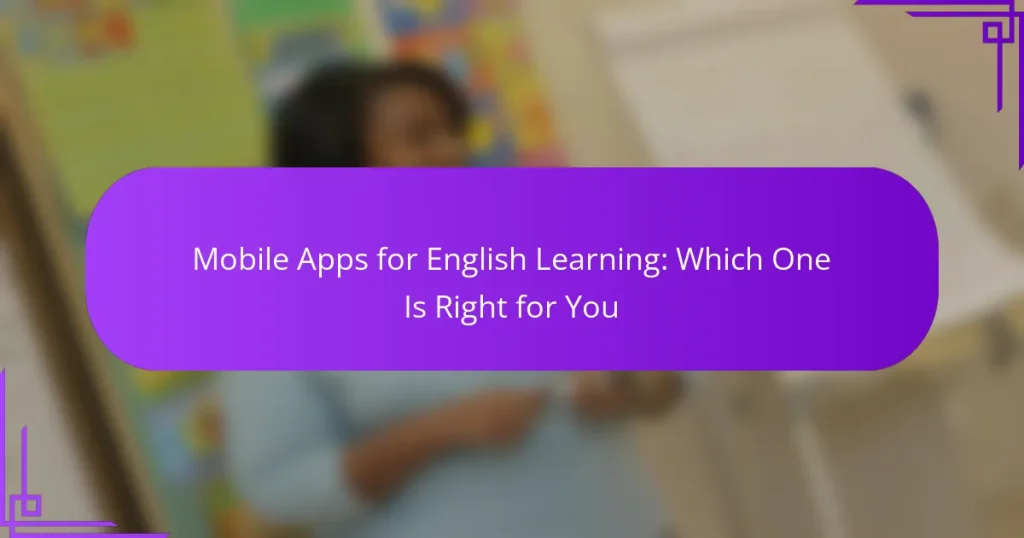With a plethora of mobile apps available for learning English, finding the right one can be a game-changer in your language journey. Each app, from Duolingo to Babbel, offers distinct features tailored to various learning styles and goals, making it essential to choose one that aligns with your needs. Consider factors like user interface, content variety, and community support to enhance your learning experience and maximize your progress.

Which mobile apps are best for learning English in the US?
Several mobile apps stand out for learning English in the US, each offering unique features and approaches. Popular options include Duolingo, Babbel, Rosetta Stone, Busuu, and Memrise, catering to different learning styles and goals.
Duolingo
Duolingo is a gamified language-learning app that uses bite-sized lessons to teach English. Users can practice vocabulary, grammar, and pronunciation through interactive exercises that feel like games.
It’s free to use with optional in-app purchases for additional features. The app’s structured approach makes it suitable for beginners and casual learners, but it may not provide in-depth grammar explanations.
Babbel
Babbel focuses on conversation skills and practical vocabulary, making it ideal for learners who want to use English in real-life situations. Lessons are designed by linguistic experts and cover various topics relevant to daily life.
While Babbel requires a subscription, it offers a more comprehensive learning experience compared to free apps. Users should consider their learning goals, as Babbel is particularly effective for those aiming to achieve conversational fluency.
Rosetta Stone
Rosetta Stone uses an immersive method, teaching English through context and visual cues without translations. This approach encourages learners to think in English, which can enhance retention and understanding.
It’s a subscription-based service and is known for its robust speech recognition technology, which helps improve pronunciation. However, some users may find the lack of grammar explanations challenging.
Busuu
Busuu combines self-paced learning with community interaction, allowing users to practice with native speakers. The app offers personalized study plans and feedback on writing and speaking exercises.
Busuu has both free and premium versions, with the latter providing access to more advanced features. It’s a good choice for learners who value social interaction and feedback in their language studies.
Memrise
Memrise focuses on vocabulary acquisition through spaced repetition and mnemonic techniques. Users can learn English words and phrases in context, which aids in long-term retention.
The app includes user-generated content, allowing learners to explore various topics and dialects. While Memrise is effective for vocabulary building, it may not cover grammar as thoroughly as other apps, so users should supplement their learning accordingly.

How do mobile apps enhance English learning?
Mobile apps enhance English learning by providing interactive and engaging platforms that cater to various learning styles. They offer flexibility, allowing users to practice anytime and anywhere, which can significantly improve language acquisition.
Interactive exercises
Interactive exercises in mobile apps promote active engagement, making learning more effective. These exercises often include quizzes, fill-in-the-blank activities, and conversation simulations that require users to apply their knowledge in real-time.
For instance, apps like Duolingo and Babbel use interactive exercises to reinforce vocabulary and grammar through repetition and context. This hands-on approach helps learners retain information better than passive methods.
Gamification elements
Gamification elements, such as points, badges, and leaderboards, motivate learners to stay committed to their studies. By turning language learning into a game, users are encouraged to complete lessons and challenges, making the process enjoyable.
Apps like Memrise and Busuu incorporate these elements to create a competitive environment that can drive progress. Users often find themselves more willing to practice regularly when they can track their achievements and compete with friends.
Personalized learning paths
Personalized learning paths tailor the educational experience to individual needs, allowing users to focus on areas where they need improvement. Many apps assess a learner’s proficiency level and adapt content accordingly, ensuring that lessons are relevant and challenging.
For example, Rosetta Stone uses adaptive learning technology to adjust its curriculum based on user performance. This customization helps learners progress at their own pace, which can lead to better outcomes and increased confidence in their language skills.

What features should you consider in an English learning app?
When choosing an English learning app, consider features that enhance your learning experience, such as user interface, content variety, progress tracking, and community support. These elements can significantly impact your engagement and effectiveness in mastering the language.
User interface
A user-friendly interface is crucial for a smooth learning experience. Look for apps that are intuitive and easy to navigate, allowing you to focus on learning rather than figuring out how to use the app. Features like clear menus, responsive design, and visually appealing layouts can enhance your motivation.
Consider whether the app offers customization options, such as changing themes or font sizes, to suit your preferences. A well-designed interface can make a significant difference in how often you use the app and how effectively you learn.
Content variety
Content variety is essential for maintaining interest and catering to different learning styles. Choose apps that offer a mix of reading, listening, speaking, and writing exercises. This approach helps reinforce language skills and keeps the learning process engaging.
Look for apps that provide diverse topics, such as travel, business, or culture, to ensure you encounter real-world language use. Some apps may also include games or interactive quizzes, which can make learning more enjoyable and effective.
Progress tracking
Effective progress tracking helps you monitor your language learning journey. Opt for apps that provide clear metrics, such as daily practice time, completed lessons, or skill assessments. This feedback can motivate you to stay consistent and set achievable goals.
Some apps offer personalized learning paths based on your performance, allowing you to focus on areas that need improvement. Regularly reviewing your progress can help you identify strengths and weaknesses, guiding your study efforts more efficiently.
Community support
Community support can enhance your learning experience by providing opportunities for interaction and practice. Look for apps that include forums, chat features, or social media groups where you can connect with other learners or native speakers. Engaging with a community can boost your confidence and provide valuable insights.
Consider whether the app offers features like language exchange or peer feedback, which can facilitate real conversations and practical language use. A supportive community can make the learning process more enjoyable and less isolating.

How do pricing models vary among English learning apps?
Pricing models for English learning apps can differ significantly, affecting accessibility and user experience. Users can choose from free options, subscription plans, one-time purchases, or trial periods, each with its own advantages and limitations.
Free vs. subscription models
Free models often provide basic features, allowing users to access limited content without any cost. However, these may include ads or restrictions on usage, which can hinder the learning experience.
Subscription models typically offer a wider range of resources, including interactive lessons, personalized feedback, and progress tracking. Monthly fees can range from around $10 to $30, depending on the app’s offerings and features.
One-time purchase options
One-time purchase options allow users to buy the app outright, providing access to all features without ongoing fees. Prices for these apps can vary widely, often falling between $20 and $100.
This model is beneficial for users who prefer not to commit to recurring payments, but it may lack the continuous updates and new content that subscription models offer.
Trial periods
Many English learning apps offer trial periods, typically lasting from one week to one month, allowing users to explore premium features before committing financially. This is a great way to evaluate the app’s effectiveness and suitability for individual learning needs.
During the trial, users should assess the quality of content, user interface, and overall engagement. Be mindful of automatic renewals, as some apps may start charging after the trial ends unless canceled beforehand.

What are the pros and cons of popular English learning apps?
Popular English learning apps offer various advantages and disadvantages depending on your learning style and goals. Understanding these can help you choose the right app for your needs.
Duolingo pros and cons
Duolingo is a widely used app that gamifies language learning, making it engaging and fun. Its strengths include a user-friendly interface, bite-sized lessons, and a wide range of languages, which can help maintain motivation.
However, Duolingo has limitations. While it is excellent for vocabulary and basic grammar, it may not provide enough depth for advanced learners or conversational practice. Additionally, some users find the repetitive nature of the exercises tedious over time.
To maximize your experience with Duolingo, set daily goals to maintain consistency and supplement your learning with other resources, such as conversation partners or grammar books. Avoid relying solely on the app for fluency; instead, use it as a tool within a broader learning strategy.


